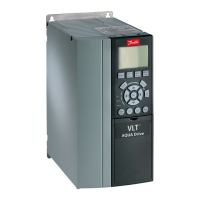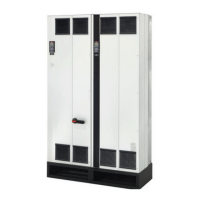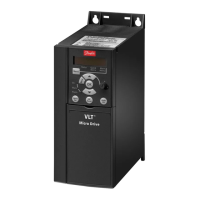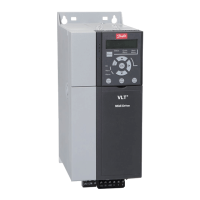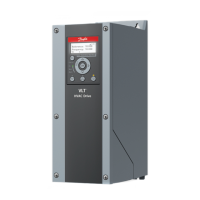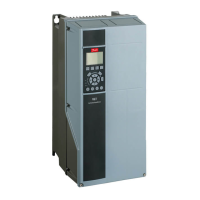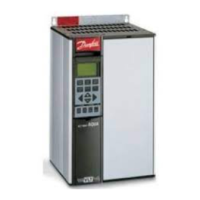The response from the slave to the master is:
119E H
PKE
IND
PWE
high
PWE
low
0000 H 0000 H 03E8 H
130BA093.10
Figure 3.53 Response from Slave
3.8.8.2 Reading a Parameter Value
Read the value in 3-41 Ramp 1 Ramp-up Time.
PKE=1155 hex - Read parameter value in 3-41 Ramp 1
Ramp-up Time.
IND=0000 hex
PWEHIGH=0000 hex
PWELOW=0000 hex
1155 H
PKE IND PWE
high
PWE
low
0000 H 0000 H 0000 H
130BA094.10
Figure 3.54 Parameter Value
If the value in 3-41 Ramp 1 Ramp-up Time is 10 s, the
response from the slave to the master is
Figure 3.55 Response from Slave
3E8 hex corresponds to 1000 decimal. The conversion
index for 3-41 Ramp 1 Ramp-up Time is -2, i.e., 0.01.
3-41 Ramp 1 Ramp-up Time is of the type Unsigned 32.
3.8.9
Modbus RTU Protocol
3.8.9.1 Assumptions
Danfoss assumes that the installed controller supports the
interfaces in this document, and strictly observes all
requirements and limitations stipulated in the controller
and adjustable frequency drive.
The built-in Modbus RTU (Remote Terminal Unit) is
designed to communicate with any controller that
supports the interfaces dened in this document. It is
assumed that the user has full knowledge of the
capabilities and limitations of the controller.
3.8.9.2
Modbus RTU Overview
Regardless of the type of physical communication
networks, the Modbus RTU overview describes the process
a controller uses to request access to another device. This
process includes how the Modbus RTU responds to
requests from another device, and how errors are detected
and reported. It also establishes a common format for the
layout and contents of message elds.
During communications over a Modbus RTU network, the
protocol:
•
Determines how each controller learns its device
address.
•
Recognizes a message addressed to it.
•
Determines which actions to take.
•
Extracts any data or other information contained
in the message.
If a reply is required, the controller constructs the reply
message and sends it.
Controllers communicate using a master-slave technique in
which only the master can initiate transactions (called
queries). Slaves respond by supplying the requested data
to the master, or by taking the action requested in the
query.
The master can address individual slaves, or initiate a
broadcast message to all slaves. Slaves return a response
to queries that are addressed to them individually. No
responses are returned to broadcast queries from the
master. The Modbus RTU protocol establishes the format
for the master’s query by providing:
•
The device (or broadcast) address.
•
A function code
dening the requested action.
•
Any data to be sent.
•
An error-checking eld.
The slave’s response message is also constructed using
Modbus protocol. It contains elds conrming the action
taken, any data to be returned and an error-checking eld.
If an error occurs in receipt of the message, or if the slave
is unable to perform the requested action, the slave
constructs an error message and sends it in response or a
timeout occurs.
System Integration
Design Guide
MG20N622 Danfoss A/S © 09/2014 All rights reserved. 87
3 3
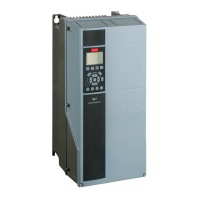
